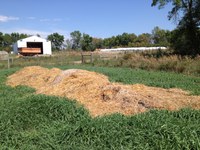Dispose of Dead Livestock Quickly
(Click the image below to view a high-resolution image that can be downloaded)
Some producers in southwestern North Dakota lost livestock due to last weekend’s unseasonal blizzard.
“Disposing of carcasses as soon as possible is imperative so the spread of disease and pollution does not occur,” says Mary Berg, an area Extension livestock environmental management specialist at North Dakota State University’s Carrington Research Extension Center.
Rendering, incineration, burial and composting are approved methods of carcass disposal in North Dakota.
Composting is a naturally occurring process that breaks the carcass into basic elements via microorganisms and heat generated during composting.
“It is a simple process that requires few materials and minimal maintenance,” says Emily Kline, another area Extension livestock environmental management specialist at the Carrington Research Extension Center.
Here are tips from Berg and Kline on how to build a mortality compost pile or windrow:
- If composting one animal, build a pile.
- If composting several animals, build a windrow.
- You’ll need base material such as straw or old hay, bulking material such as manure or spoiled silage, and cover material such as straw, old hay or sawdust.
Use this process for composting:
- Start with 2 feet of base material in a windrow or circle, depending on how many carcasses will be composted.
- Lay the carcass on top of the base. Lance the rumen of mature cattle to ensure eruption does not occur. Have at least 1 foot of base material between the perimeter of the carcass and the edge of the base.
- Cover the carcass with 8 to 10 inches of bulking material.
- Cover the entire pile or windrow with 2 feet of cover material. The cover material should be placed on the top and sides, with no part of the carcass showing. The pile needs a good cap to keep predators out and seal in heat.
To maintain the compost site:
- Leave the pile or windrow undisturbed to keep heat sealed in during the very cold winter months.
- Aerate the pile every two months using a loader from early spring until late fall.
- Make sure sufficient cover material always is present.
For more information:
- Check out the eXtension Livestock and Poultry Environmental Learning Center’s video series at http://tinyurl.com/ktghhlw.
- Contact Berg and Kline at (701) 652-2951 or by email at mary.berg@ndsu.edu or emily.m.kline@ndsu.edu.
- Visit NDSU’s livestock environmental management website at http://www.ag.ndsu.edu/lem.
- See NDSU’s “Animal Carcass Disposal Options” publication at http://tinyurl.com/carcassdisposal.
NDSU Agriculture Communication - Oct. 11, 2013
| Source: | Mary Berg, (701) 652-2951, mary.berg@ndsu.edu |
|---|---|
| Source: | Emily Kline, (701) 652-2951, emily.m.kline@ndsu.edu |
| Editor: | Ellen Crawford, (701) 231-5391, ellen.crawford@ndsu.edu |


